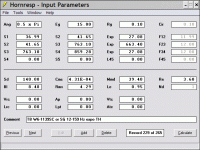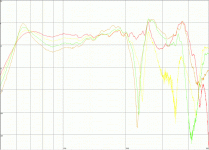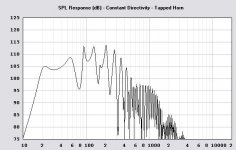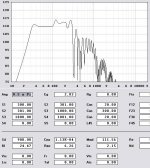GM said:
That would be nice, I know the geometrics for spirals, but not a simple way to calc folding up a long TH, which will be a requirement for this corner loaded long, skinny TH of only ~187.6 L. Talk about packing '10 lbs into a 2 lb bag':
GM
Do you think that typical room gain would flatten out the response of this design to 20hz or so? If so, could you post dimensions for this design? Also, what drive is that?
Volvotreter said:Good evening.
After listening some evenings with my friends, one of them wanted to know if it would be possible to build something like that but smaller (better WAF, what the one for the 15" doesn't have). I serarched a lot for possible drivers, and to make a long storry short, I ended up with a 6.5" Tangband. Since they are so cheap and to have some more headroom and flexibility in regards to placement I directly built two units:
Erik
Good stuff - thanks for posting this. I've modelled some TH with this driver that look awfully similar to what you built, so it's very cool to see that they deliver in the real world. I have two W8-740c drivers already, but at the price I may pick up some of the 6.5's and take advantage of the even smaller size.
Chris8sirhC said:
Do you think that typical room gain would flatten out the response of this design to 20hz or so? If so, could you post dimensions for this design? Also, what drive is that?
I've only measured one room with the near ideal gain required to completely flatten this one, but even if it only adds the ~4 dB of my room that's still almost 120 dB/m once EQ'd flat with plenty of dynamic headroom in the mid-bass for bass guitars, drums, organs, etc., so no need to be greedy.
15 V to 12.29 mm/18 Hz, so ~56 W.
GM
Attachments
Something i just realized by playing in Hornresp...
If you have found a nice TH design, but want to go an octave lower, you can use the same driver, you only have to use 4 of it, double the length of every horn segment and multiply every area by 4. this gives nearly the same response, only transposed one octave lower.
This probably files under the "i found out something which was obvious to all others" topic
BTW, does someone know, why the 18 Sound 15LW1401 for example gives such a great response in tapped horns? Its response is really flat and extended into the midbass, without the usual dips and peaks. Are there more drivers, that model so well, maybe smaller ones?
If you have found a nice TH design, but want to go an octave lower, you can use the same driver, you only have to use 4 of it, double the length of every horn segment and multiply every area by 4. this gives nearly the same response, only transposed one octave lower.
This probably files under the "i found out something which was obvious to all others" topic
BTW, does someone know, why the 18 Sound 15LW1401 for example gives such a great response in tapped horns? Its response is really flat and extended into the midbass, without the usual dips and peaks. Are there more drivers, that model so well, maybe smaller ones?
good evening,
here is the promised sketch on how I do the folding:
How to fold
It is not a 100% accurate but I think it is acceptable, easy and quick.
@tb46
I would describe the sonic differences as following:
Both tapped horns sound very good. The sound is effortless and
well controlled. Exactly what I was looking for. The bigger sounds a
little better than the small (even more relaxed). The lower the
better it sounds. Just very pleasing for the ears.
For me both TH's are equally well suited for music as well as HT.
Both are capable of doing big bad growl being required to reproduce
tension and depth. But same here: The larger does it a little better
but that doesn't mean that the smaller ones are insufficient.
They are more than enough I think. You'll need very forgiving
neighbors to drive them to the limits.
Using 24dB/oct seems to be fine. I did not test different slops though.
Yesterday evening we installed them at my friends place. They are
intended to support his off the shelf magnat system on the bottom
(2x 6,5" aluminum cone and 1" ceramic dome in d'apolito). When
crossed over at 40Hz (evening out the rising response) they
perfectly mate up with his mains xing in at 75Hz.
It doesn't need high levels - even on low levels it sounds very nice.
He and another buddy were quite impressed (especially when
considering the investment).
best wishes.
 Erik
Erik
here is the promised sketch on how I do the folding:
How to fold
It is not a 100% accurate but I think it is acceptable, easy and quick.
@tb46
I would describe the sonic differences as following:
Both tapped horns sound very good. The sound is effortless and
well controlled. Exactly what I was looking for. The bigger sounds a
little better than the small (even more relaxed). The lower the
better it sounds. Just very pleasing for the ears.
For me both TH's are equally well suited for music as well as HT.
Both are capable of doing big bad growl being required to reproduce
tension and depth. But same here: The larger does it a little better
but that doesn't mean that the smaller ones are insufficient.
They are more than enough I think. You'll need very forgiving
neighbors to drive them to the limits.
Using 24dB/oct seems to be fine. I did not test different slops though.
Yesterday evening we installed them at my friends place. They are
intended to support his off the shelf magnat system on the bottom
(2x 6,5" aluminum cone and 1" ceramic dome in d'apolito). When
crossed over at 40Hz (evening out the rising response) they
perfectly mate up with his mains xing in at 75Hz.
It doesn't need high levels - even on low levels it sounds very nice.
He and another buddy were quite impressed (especially when
considering the investment).
best wishes.
 Erik
ErikTapped horn distortion question
After studying tapped horn/pipe designs for a while, one question remains in my mind. Most designs others and I have found feature high acoustic gain peaks in the frequency range just above the first null above the pass band (e.g. around 100 Hz and up in recently posted examples). These peaks amplify distortion by as much as 10 or 20 dB, and that could be potentially very audible 5th harmonic of ~20 Hz.
Now given how very much more audible 100 Hz is than 20 Hz at a given SPL, and noting that the gain at 100 Hz (or nearby peak) is large, why is there not more comment about the harmonic distortion in TH subs?
The higher efficiency of TH for a given volume allows half the excursion that would be needed in a direct radiator, and so the distortion is somewhat smaller. It would seem however, that a sine sweep would still reveal distortion peaks corresponding to those pipe/horn modes. Has someone tried?
I realise that the typical hornresp models might not be spot on with respect to the Q of the modes (due to unmodelled loss) but nevertheless I feel I must be missing something or THs would be less attractive than they are.
I'm on the point of buying wood, but have reached a state of indecision over the significance of the aforementioned response peaks. Quite the opposite of bandpass action as in unity horns, where the HD is suppressed. I find the HD in my reflex sub easy enough to hear, at times, if I play it a bit loud.
Ken
After studying tapped horn/pipe designs for a while, one question remains in my mind. Most designs others and I have found feature high acoustic gain peaks in the frequency range just above the first null above the pass band (e.g. around 100 Hz and up in recently posted examples). These peaks amplify distortion by as much as 10 or 20 dB, and that could be potentially very audible 5th harmonic of ~20 Hz.
Now given how very much more audible 100 Hz is than 20 Hz at a given SPL, and noting that the gain at 100 Hz (or nearby peak) is large, why is there not more comment about the harmonic distortion in TH subs?
The higher efficiency of TH for a given volume allows half the excursion that would be needed in a direct radiator, and so the distortion is somewhat smaller. It would seem however, that a sine sweep would still reveal distortion peaks corresponding to those pipe/horn modes. Has someone tried?
I realise that the typical hornresp models might not be spot on with respect to the Q of the modes (due to unmodelled loss) but nevertheless I feel I must be missing something or THs would be less attractive than they are.
I'm on the point of buying wood, but have reached a state of indecision over the significance of the aforementioned response peaks. Quite the opposite of bandpass action as in unity horns, where the HD is suppressed. I find the HD in my reflex sub easy enough to hear, at times, if I play it a bit loud.
Ken
kstrain, i build my first TH out of 10inch hifi woofers, they sounded better as in the previous bassreflex box, went deeper, were louder. i was really amazed. they had also these peaks in the upper response, but they sounded nice crossed at 50hz.
There are drivers, which have no such peaks, and roll of nicely. cowanaudio mentioned a few.
There are drivers, which have no such peaks, and roll of nicely. cowanaudio mentioned a few.
30-300hz TH
MaVo, can you post the Hornresp simulation for those 2 drivers
MaVo said:@GM - What you say sounds very reasonable. Also, its way over my head to think about when and why a TH would not work as in the simulation.
@cowanaudio - Thanks for mentioning these drivers, a quick sim in hornresp gave a near flat response from about 30-300hz with falling response to both sides. that is what i was in search of. now i have to find out, if there are drivers that can achieve this in the 20-100hz area and what is so special about the ts parameter combination.
@volvotreter - great to see more success stories! Have fun
MaVo, can you post the Hornresp simulation for those 2 drivers
Volvotreter_TH_review
Hi Erik: Thanks for the review. I think I have a much better idea of what to expect now. As far as leveling out the response I still feel that a simple passive filter would be helpful, kind of like the recommended filtering for the RiPols, anyway, it is good to know that they are not as critical as the curves look.
kstrain: Attenuating the peaks with resonators would make the job of the crossover much easier, and probably address your concerns. Obviously, this would require before and after measurements and respective tuning steps during the construction, and sofar the consensus seems to be that this may be more trouble than it is worth. But keep it in mind.
Hi Erik: Thanks for the review. I think I have a much better idea of what to expect now. As far as leveling out the response I still feel that a simple passive filter would be helpful, kind of like the recommended filtering for the RiPols, anyway, it is good to know that they are not as critical as the curves look.
kstrain: Attenuating the peaks with resonators would make the job of the crossover much easier, and probably address your concerns. Obviously, this would require before and after measurements and respective tuning steps during the construction, and sofar the consensus seems to be that this may be more trouble than it is worth. But keep it in mind.
G'day kstrain
I think you touched on the truth in your post. Almost everybody here is showing graphs of modeled responses. The measured responses are usually smoother, most likely to do with the unmodeled losses you mentioned. Have a look at the red trace in this plot. It is the real measured unsmoothed response of a tapped horn. It shows out of band response peaks, but of a much lower magnitude than some of these models would suggest. BTW the plot is 6dB/div. so the 1st and second peak are about 3dB high.
Just do the tapped horn and don't procrastinate. If the design is sound, you'll love the results.
Cheers
William Cowan
I think you touched on the truth in your post. Almost everybody here is showing graphs of modeled responses. The measured responses are usually smoother, most likely to do with the unmodeled losses you mentioned. Have a look at the red trace in this plot. It is the real measured unsmoothed response of a tapped horn. It shows out of band response peaks, but of a much lower magnitude than some of these models would suggest. BTW the plot is 6dB/div. so the 1st and second peak are about 3dB high.
Just do the tapped horn and don't procrastinate. If the design is sound, you'll love the results.
Cheers
William Cowan
Attachments
Partly answering my own question...
There could be a resonance due to the long unfolded straight horn paths. Will the resonance occur at pathlength = wavelength/2 (for example 1 meter of straight horn has a resonance at 344m/s / 2m = 172hz) ?
I am inquiring this, because im currently searching for a woofer, that can cross at least at 130hz, i wouldnt mind 200hz and goes as low as possible.
Tapped horns with rather big mouths and an exponential flare, such as the TH115, seem to be really well damped and usable for higher frequencies.
Parameters of woofers that work in those things are:
qes around 0,3
fs 40-45hz
vas depends on woofer size, around 50 for 12" , around 100 for 15"
qms doesnt matter much
The Beyma 12P1000ND and 15P1200ND are such woofers.
(thanks to cowanaudio for throwing in those woofers and to GM for modelling all those THs, both of it got me thinking about this)
There could be a resonance due to the long unfolded straight horn paths. Will the resonance occur at pathlength = wavelength/2 (for example 1 meter of straight horn has a resonance at 344m/s / 2m = 172hz) ?
I am inquiring this, because im currently searching for a woofer, that can cross at least at 130hz, i wouldnt mind 200hz and goes as low as possible.
Tapped horns with rather big mouths and an exponential flare, such as the TH115, seem to be really well damped and usable for higher frequencies.
Parameters of woofers that work in those things are:
qes around 0,3
fs 40-45hz
vas depends on woofer size, around 50 for 12" , around 100 for 15"
qms doesnt matter much
The Beyma 12P1000ND and 15P1200ND are such woofers.
(thanks to cowanaudio for throwing in those woofers and to GM for modelling all those THs, both of it got me thinking about this)
sawdust time
Thanks for the advice - procrastinating is exactly what I've been doing. I'm looking at various foldings (and various room locations) before making sawdust - but sawdust I will make!
Ken
cowanaudio said:G'day kstrain
Just do the tapped horn and don't procrastinate. If the design is sound, you'll love the results.
Cheers
William Cowan
Thanks for the advice - procrastinating is exactly what I've been doing. I'm looking at various foldings (and various room locations) before making sawdust - but sawdust I will make!
Ken
In my quest for room gain simulation in AkAbak, i've tried coupling a rectangular enclosure the size of the room to the radiator element at the mouth and then put the measurement point *inside* that box.
It seems that is not possible (keeps complaining radiator is inside a wall), but the resulting SPL plot was somewhat interesting:
it seems I modeled a TH with a huge side-chamber that acts like a low pass -6dB filter.
Does anyone have an idea to find at what freq the room gain starts and if possible how I can implement this at the output stage? So far I can put an inverse active HP filter in the system (ie modifying the amp), but then the excursion graph and max SPL plot is off.
Also, am I the only one who is running into hofman's iron law? By trying to squeeze a TH into the same volume of my bassreflex, there seems to be no gain compared to the current cabinet, even if a TH is a bandpass enclosure? With this I mean that when I model my TH in half space, it has 91dB sensitivity, compared to the 90dB of my BR. Where is the advantage, unless a BR doesn't benefits as much from corner loading as a TH ?
Also, when accidently modeling a rear loaded horn with an average size back chamber, this seemed to be more usefull with room gain than trying to "sculpture" a TH.
It seems that is not possible (keeps complaining radiator is inside a wall), but the resulting SPL plot was somewhat interesting:
it seems I modeled a TH with a huge side-chamber that acts like a low pass -6dB filter.
Does anyone have an idea to find at what freq the room gain starts and if possible how I can implement this at the output stage? So far I can put an inverse active HP filter in the system (ie modifying the amp), but then the excursion graph and max SPL plot is off.
Also, am I the only one who is running into hofman's iron law? By trying to squeeze a TH into the same volume of my bassreflex, there seems to be no gain compared to the current cabinet, even if a TH is a bandpass enclosure? With this I mean that when I model my TH in half space, it has 91dB sensitivity, compared to the 90dB of my BR. Where is the advantage, unless a BR doesn't benefits as much from corner loading as a TH ?
Also, when accidently modeling a rear loaded horn with an average size back chamber, this seemed to be more usefull with room gain than trying to "sculpture" a TH.
jnb said:Is it worth the effort of rounding the bend and flaring the mouth (so it looks like a sax?)
with the wavelengths beeing so long, i doubt that it is beneficial. rounding is important, when the WL is about the internal size of the horn. thats not the case with subs.
New tapped horn. This is the layout. Im going to use two pairs of the drivers in the picture isobaric. two and two face to face, with a metalrod going through the magnets to conect them realy hard and stable.
An externally hosted image should be here but it was not working when we last tested it.
- Home
- Loudspeakers
- Subwoofers
- Collaborative Tapped horn project



